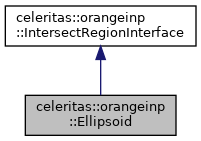|
Celeritas 0.7.0-dev.245+develop.a7be925e
|
|
Celeritas 0.7.0-dev.245+develop.a7be925e
|
An axis-aligned ellipsoid centered at the origin. More...
#include <IntersectRegion.hh>

Public Member Functions | |
| Ellipsoid (Real3 const &radii) | |
| Construct with radius along each Cartesian axis. | |
| void | build (IntersectSurfaceBuilder &) const final |
| Build surfaces. | |
| void | output (JsonPimpl *) const final |
| Write output to the given JSON object. | |
| bool | encloses (Ellipsoid const &other) const |
| Whether this encloses another ellipsoid. | |
| Real3 const & | radii () const |
| Radius along each axis. | |
| real_type | radius (Axis ax) const |
| Get the radius along a single axis. | |
Additional Inherited Members | |
 Protected Member Functions inherited from celeritas::orangeinp::IntersectRegionInterface Protected Member Functions inherited from celeritas::orangeinp::IntersectRegionInterface | |
| IntersectRegionInterface (IntersectRegionInterface const &)=default | |
| IntersectRegionInterface & | operator= (IntersectRegionInterface const &)=default |
| IntersectRegionInterface (IntersectRegionInterface &&)=default | |
| IntersectRegionInterface & | operator= (IntersectRegionInterface &&)=default |
An axis-aligned ellipsoid centered at the origin.
The ellipsoid is constructed with the three radial lengths. For a length scale L , the quadric it creates has second-order terms that are \( O(1) \) and a zeroth order term that's \( O(L^2) \). Translations on that length scale will preserve the accuracy of the quadratic solution.
There are many scalings of the quadric equation that produce unitary second-order terms if the ellipsoid's radii are identical:
\[ \frac{k}{r_x^2} x^2 + \frac{k}{r_y^2} y^2 + \frac{k}{r_z^2} z^2 = k \]
but we make the ad hoc decision to choose \( k = \min r_i \max r_i \) to avoid irrational normalization constants, which makes unit tests and output easier to read.
|
finalvirtual |
Build surfaces.
Implements celeritas::orangeinp::IntersectRegionInterface.
Write output to the given JSON object.
Implements celeritas::orangeinp::IntersectRegionInterface.